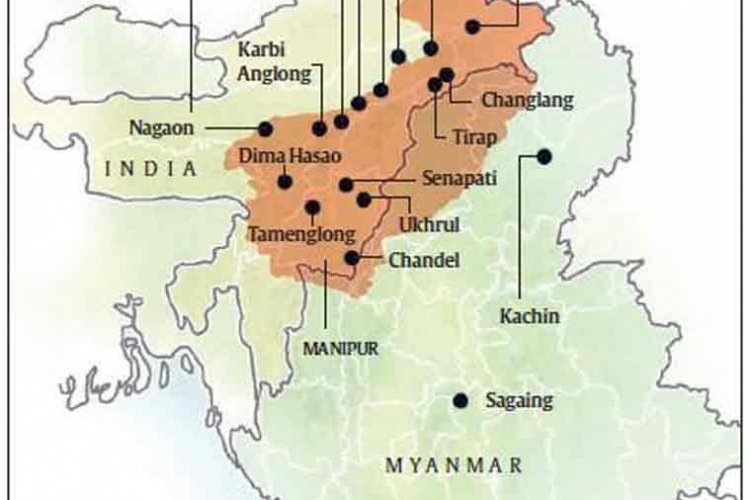Nagaland Insurgency : Briefed
In NEWS:
India asks Myanmar to crackdown on Naga rebels
According to The Irrawaddy, a Myanmar-based publication, the Tatmadaw(Myanmar’s army) took over the NSCN-K’s headquarters, three outposts and two military training schools in the Taga area of Sagaing Region. The schools were run by rebel groups “fighting the Indian government in Assam and Manipur” under the NSCN-K’s supervision.
What is the Naga political issue?
The British annexed Assam in 1826, and in 1881, the Naga Hills too became part of British India. The first sign of Naga resistance was seen in the formation of the Naga Club in 1918, which told the Simon Commission in 1929 “to leave us alone to determine for ourselves as in ancient times”. In 1946 came the Naga National Council (NNC), which, under the leadership of Angami Zapu Phizo, declared Nagaland an independent state on August 14, 1947. The NNC resolved to establish a “sovereign Naga state” and conducted a “referendum” in 1951, in which “99 percent” supported an “independent” Nagaland.
When did the armed movement begin?
On March, 1952, Phizo formed the underground Naga Federal Government (NFG) and the Naga Federal Army (NFA). The Government of India sent in the Army to crush the insurgency and, in 1958, enacted the Armed Forces (Special Powers) Act.
Peace Efforts:
The Naga Hills, a district of Assam, was upgraded to a state in 1963, by also adding the Tuensang Tract that was then part of NEFA. In the next year, Jai Prakash Narayan, Assam Chief Minister formed a Peace Mission, and got the government and NNC to sign an agreement to suspend operations . But the NNC/NFG/NFA continued to indulge in violence, and after six rounds of talks, the Peace Mission was abandoned in 1967, and a massive counter-insurgency operation launched.
NSCN
On November, 1975, the government got a section of NNC leaders to sign the Shillong Accord, under which this section of NNC and NFG agreed to give up arms.The other faction of NNC who were at that time in China, refused to accept the Shillong Accord, and formed the National Socialist Council of Nagaland in 1980. In 1988, the NSCN split into NSCN (IM) and NSCN (K) after a violent clash. While the NNC began to fade away, and Phizo died in London in 1991, the NSCN (IM) came to be seen as the “mother of all insurgencies” in the region.
What did the NSCN (IM) want?
A “Greater Nagalim” comprising “all contiguous Naga-inhabited areas”, along with Nagaland. That included several districts of Assam, Arunachal and Manipur, as also a large tract of Myanmar. The map of “Greater Nagalim” has about 1,20,000 sq km, while the state of Nagaland consists of 16,527 sq km. The claims have always kept Assam, Manipur and Arunachal Pradesh wary of a peace settlement that might affect their territories. The Nagaland Assembly has endorsed the ‘Greater Nagalim’ demand — “Integration of all Naga-inhabited contiguous areas under one administrative umbrella”
How have Manipur, Assam and Arunachal Pradesh reacted?
Leaders cutting across party lines have preferred to wait and watch. Nobody in these three states would allow even an inch of their land to be added to a ‘Greater Nagalim’, if at all that term is part of the accord.
Government of India’s Initiative
The Government of India signed a ceasefire agreement with NSCN (IM) on July , 1997, which came into effect on August , 1997. Over 80 rounds of talks between the two sides were held subsequently.For the NSCN (IM), the Modi government continues from where Vajpayee left. Neither Indira Gandhi nor Rajiv Gandhi ever visited Kohima as Prime Minister. A visit by Jawaharlal Nehru had witnessed an embarrassing spectacle of 5,000 Nagas turning their backs on the PM after he rejected the demand for a “sovereign” Nagaland on March, 1953. Morarji Desai and H D Deve Gowda travelled to Kohima, but neither of them is remembered with the fondness that the Nagas have for Vajpayee. The first NDA Prime Minister not only recognised the “unique history” of the Nagas, but also admitted that mistakes had been committed, and lamented the unnecessary spilling of blood in the state.
June 1947: Naga-Akbar Hydari Agreement
That the right of the Nagas to develop themselves according to their freely expressed wishes is recognized.
Silver Lining: “The Governor of Assam as the Agent of the Government of the Indian Union will have a special responsibility for a period of 10 years to ensure the observance of the agreement, at the end of this period the Naga Council will be asked whether they require the above agreement to be extended for a further period or a new agreement regarding the future of Naga people arrived at.
July 1960: Sixteen-point Agreement with the Naga People’s Convention
Nagaland formed as a state, under the charge of the Ministry of External Affairs
“No Act or law passed by the Union Parliament affecting the following provisions shall have legal force in the Nagaland unless specially applied to it by a majority vote of the Nagaland Legislative Assembly:
(a) The Religious or Social Practices of the Nagas,
(b) The Customary Laws and Procedure,
(c) Civil and Criminal Justice so far as these concern decision according to the Naga Customary Law.”
THE CATCH: “The Naga leaders expressed the view that other Nagas inhabiting contiguous areas should be enabled to join the new state. It was pointed out to them on behalf of the Government of India that Article 3 and 4 of the Constitution provided for increasing the area of any state, but it was not possible for the Government of India to make any commitment in this regard at this stage”.
1964: Ceasefire Agreement
To facilitate these talks and taking note of the letter of August 10, 1964, the security forces will not undertake: jungle operations; raiding of camps of the underground; patrolling beyond one thousand yards of Security posts; searching of villages; aerial action; arrests; and imposition of labour by way of punishment.
1975: Shillong Agreement
Between Nagaland Governor L P Singh and underground leaders
The representatives of the underground organisations conveyed their decision, of their own volition, to accept, without condition, the Constitution of India. It was agreed that the arms, now underground, would be brought out and deposited at appointed places. Details for giving effect of this agreement will be worked out between them and representatives of the Government, the security forces, and members of the Liaison Committee.
THE CATCH: “It was agreed that the representatives of the underground organisations should have reasonable time to formulate other issues for discussion for final settlement.”
Recent Trends
The 2015 agreement was signed between the Centre and the Naga groups led by National Socialist Council of Nagaland-Isak-Muivah (NSCN-IM) after the latter agreed to give up its long-standing demand for sovereignty. There was a broad understanding on a settlement within the Indian constitutional framework, with due regard to the uniqueness of Naga history and tradition
The Government Planned for the massive Indian Army operation against militants that saw surgical strikes inside Myanmar in 2015 which was supported by the diplomatic talks on both the government level.
Now in 2019, GOI has asked and begun ops with myanmar to remove the terror threats on all its border areas. This is to be seen as an counter insurgency and counter terror ops running in purview of the preemptive actions made in neighbourhood borders for the security interests of India.Added to this the present government is working on talks to deal a peaceful and constitutional solution to nagas without compromising the integrity on the nation and recognising the unique history on nagas.


 IAS-2026 - OPTIONAL / GEOGRAPHY / PUBLIC ADMINISTRATION / SOCIOLOGY / ANTHROPOLOGY / ORIENTATION ON 03 & 04-10-2025
IAS-2026 - OPTIONAL / GEOGRAPHY / PUBLIC ADMINISTRATION / SOCIOLOGY / ANTHROPOLOGY / ORIENTATION ON 03 & 04-10-2025 